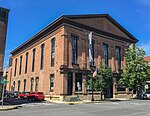Oliver Bronson House
Houses in Columbia County, New YorkHouses on the National Register of Historic Places in New York (state)National Historic Landmarks in New York (state)National Register of Historic Places in Columbia County, New YorkUse mdy dates from August 2023

The Plumb-Bronson House, also known as the Dr. Oliver Bronson House and Stables, is a historic house on Worth Avenue (United States Route 9) in Hudson, New York. Built in 1811 and significantly altered in 1839 and 1849, it is an important early example of the Hudson River Bracketed style by Alexander Jackson Davis. The house was declared a National Historic Landmark in 2003.
Excerpt from the Wikipedia article Oliver Bronson House (License: CC BY-SA 3.0, Authors, Images).Oliver Bronson House
Hudson Avenue,
Geographical coordinates (GPS) Address Phone number Website Nearby Places Show on map
Geographical coordinates (GPS)
| Latitude | Longitude |
|---|---|
| N 42.243119444444 ° | E -73.785763888889 ° |
Address
Hudson Correctional Facility
Hudson Avenue
12534
New York, United States
Open on Google Maps







